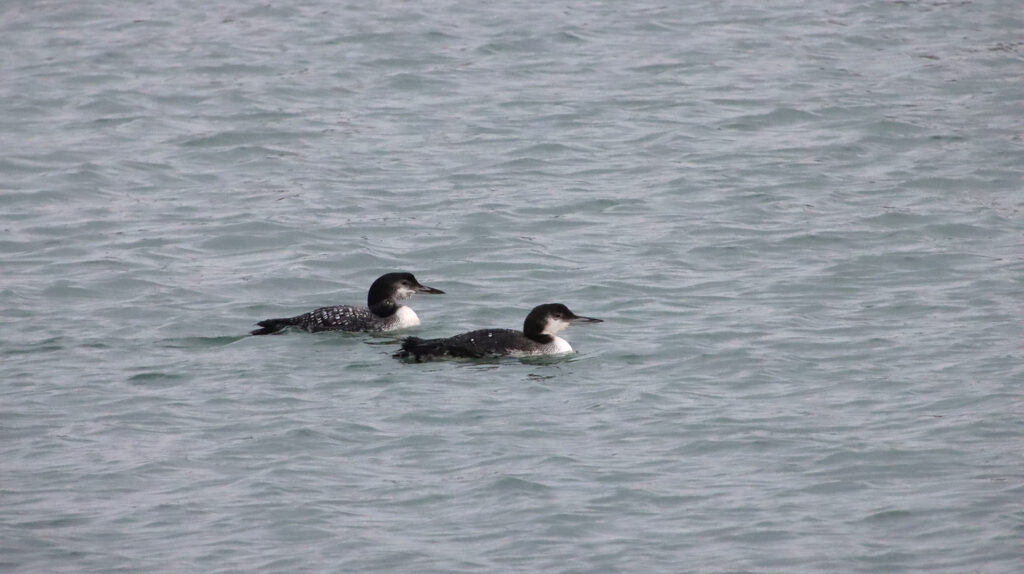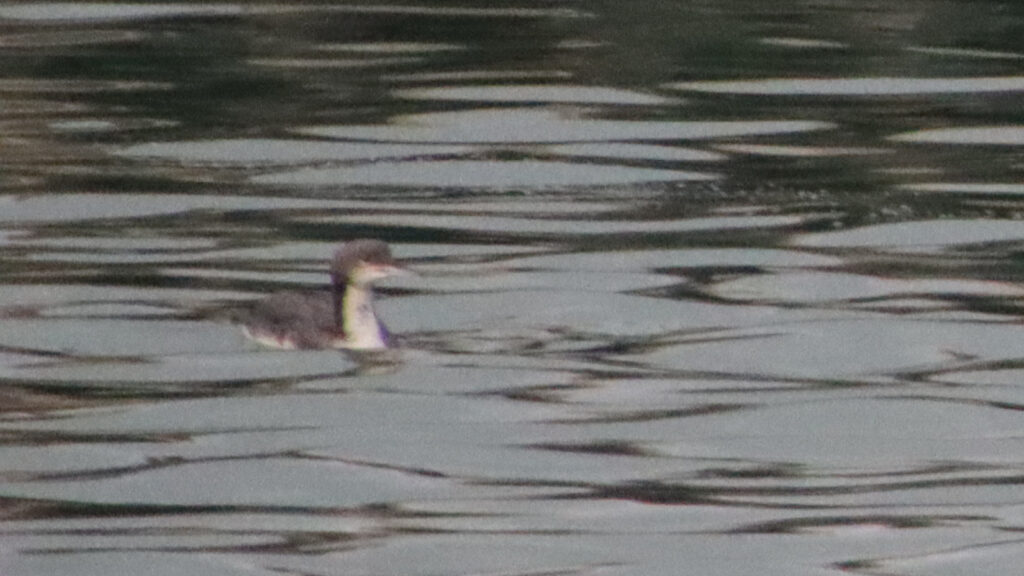This post is also available in: Dansk
Don’t forget to check the “common” birds
Sometimes you have to remember to check the “common” birds too. We usually do, but sometimes – for example, when twitching a rare bird, it is that bird (or species) you’re focused on. So sometimes you can “forget” to look at the common birds. Or you don’t even check them out – unless it’s one of those “little brown” birds that look similar to the one you’re looking for.
We experienced the above on the first weekend in December when we twitched a pair of stationary Great Northern Diver (US: Common Loons) in Hanstholm. We were on a family visit in North Jutland – more specifically in Aalborg. Besides visiting family, we had hoped for a trip to Hanstholm. A Desert Wheatear had been staying on the beach east of Hanstholm Harbor for several days. In the meantime, the country had been hit by winter with snow and cold weather, and the wheatear had not been seen lately. Unfortunately, there was a high probability that it hadn’t “just” moved to another location. it had probably struggled to find food due to the snow, and it was possible that it had not survived.
In other words, the probability of getting it as a new “tick” was very unlikely – or non-existent. Fortunately, there were other exciting and rare birds in the harbor, including two Common Loons. So bird-wise, there was still a reason to drive to Hanstholm, now we were in northern Jutland anyway.

A couple of small divers
When we got up on Saturday morning, the temperature was 8 – 9 degrees below zero! We had spent the night in Cama Coche so it was just a matter of getting the warm clothes on right away. The weather forecast for the day wasn’t ideal either, as it predicted gray, cloudy, and misty weather with the risk of snow! But we wanted to go birdwatching and set off after our morning coffee.
At the harbor in Hanstholm, the wind was freezing cold when we arrived and started scanning the harbor for divers and other birds. We were not the only ones who had braved the weather. There were 2 or 3 other people on the harbor with cameras with large lenses, that they pointed at the water. It wasn’t particularly windy, but the air temperature was below freezing and the chill factor was correspondingly low.
The harbor was very icy, so we had to move carefully around on the quays. Before long, we spotted a Black-throated Diver actively foraging. We saw it dive several times. But no Great Northern Diver at first glance. Then we spotted another small diver further away. It was also submerged for longer periods, and it was not easy to predict where it would reappear after a dive. It seemed slightly smaller than the Black-throated Diver. It also lacked the characteristic white patch at the back of its flank. Therefore, I quickly and carelessly assumed – as it later turned out – that it was probably the Red-throated Diver that had also been seen in the harbor.
As we continued our search for the Great Northern Divers, we saw both of the small divers several times – most of the time at some distance. Both were often submerged for long periods and surprisingly hard to keep track of. But the “red-throated” actually looked more like a “black-throated”. But we could check that later – for now we had to find some Great Northerns.
The article continues below this Advertisement
A Great Northern Diver and a photo with great significance
And then we spotted a Great Northern Diver. Quietly a large diver had appeared in the northeastern basin of the harbor. The Great Northern Diver is a large bird and some individuals are almost the size of a Cormorant. It had probably been there all along, but hidden from our position. After seeing it in the scope (and being sure of the identification), we would move closer for better views – and maybe the other individual was near it. On the way to the car, out of the corner of my eye, I saw that the two small divers were up and close to each other. I quickly took some photos just in case, which I then could check a little later. Little did we realize that particular one of the photos would later be of great importance.

Two Great Northern Divers
The next while we spent looking at not one, but two Great Northern Divers. They were in the northeastern harbor basin. They were quite cooperative and allowed themselves to be observed up close. For a long time, they also stayed close together. We were therefore able to take a closer look at their strong dagger-shaped bills and details of their plumage and compare them. They were both adult birds in transitional plumage. That is, they were in the process of molting their plumage and replacing the beautiful black and white summer plumage with the more subtle and grayish winter plumage.
After I had tried to phonescope some videos of the two Great Northerns, it was time for lunch and warmth in the car. It’s not easy to handle both the phone and the telescope at the same time when you’re wearing big mittens. My hands and fingers had gradually (read quickly) become quite cold. Bente had spent most of the time sheltered in the car and used it as an observation post, so she didn’t complain about cold fingers.

Shopping in Hanstholm
After lunch, the weather had not improved. Out from the sea, several snow showers drifted in over the harbor periodically reducing visibility considerably. We had seen the Great Northern Divers, which was the purpose of the trip – and actually, quite good. Therefore, we would drive back towards Aalborg. Before leaving the harbor and Hastholm, we visited the Havnebutikken to buy rubber boots for Bente. So with a clear conscience, we can say that birds and our twitch have once again contributed to the economy of a local community. We can only encourage all other birders, birdwatchers, and photographers to do the same. When twitching rare birds, or going birding in other regions, buy at least a cup of coffee, a French hotdog or something else local. That way, the local community gets a little something out of all the fuss.
It was a Pacific Diver
When back in Aalborg in the afternoon, enjoying a good cup of coffee, a message “beeps” in on BirdAlarm: Pacific Diver (Gavia pacifica), Hanstholm Harbor!
– “What! Pacific Diver – but we’ve just returned from there?!”. The message referred to the Facebook group Feltornitologen, which I immediately checked. Yes, it’s true – a post in the Facebook group shows some photos of a Pacific Diver, photographed the same afternoon. The Pacific Diver has only been seen in Denmark twice before – so it is safe to say, that’s a bit of a find.
But the bird in the photos also resembled the small diver that we saw earlier in the day. The one we never got a closer look at. I took out my camera and quickly found the photo with the two small divers seen together. In terms of quality, it was a lousy photo, and that didn’t get any better by zooming in. But in terms of documentation, it could definitely could be used – it showed a “fine” Pacific Diver swimming after a Black-throated Diver!

Now, this isn’t a field identification article, but my photo shows some of the important characteristics of a Pacific Diver. There is a hint of the “neck strap”, that may vary or even be missing. In the photo, the hint is amplified due to the grainy image. The bird has a dark flank without a white patch at the back. This is on the other hand seen on the Black-throated Diver next to it. In the photo, the diver swims high in the water, so some of the light underside is visible. Finally, the lower bill does not curve upwards towards the tip.
There was no doubt that the “common” diver was a Pacific Diver and thus a very rare bird in Denmark!
There’s always room for hindsight
It’s always easy to be in hindsight. But if it hadn’t been so damn cold and dull that Saturday morning, I’m sure we would have checked the diver better. And I’m (almost) convinced that we would have identified it to be a Pacific Diver in the field. Or at least to be a possible Pacific Diver. But we were focusing on the Great Nothern Divers, and in the back of our minds was the Desert Wheateater (which we just in case – briefly – looked for along the coast). Afterward, I was glad that I had my camera equipment with me and a photo (although bad) where we could see that it was the Pacific Diver we had seen.
But this story shows that you should also remember to look at the ordinary or common birds. Not only do you learn a lot by “knowing” them, but you might also be lucky and find something unusual now and then. An example of this you can read in A bird call leads to the discovery of Hume’s Warbler at Nyord Kirkegård.
More about the Pacific Diver in Hanstholm Havn
Unfortunately, we didn’t get any good photos of the Pacific Diver ourselves. However, many others did in the weeks that followed. Some of them can be seen on Netfugl.dk, or in these articles En Stillehavslom gik under radaren i Hanstholm – men så kom Brian forbi… and Stillehavslommen i Hanstholm – yderligere fokus på kendetegnene.
All photos © Bente Steffensen & Uffe Damm Andersen, unless otherwise stated.

